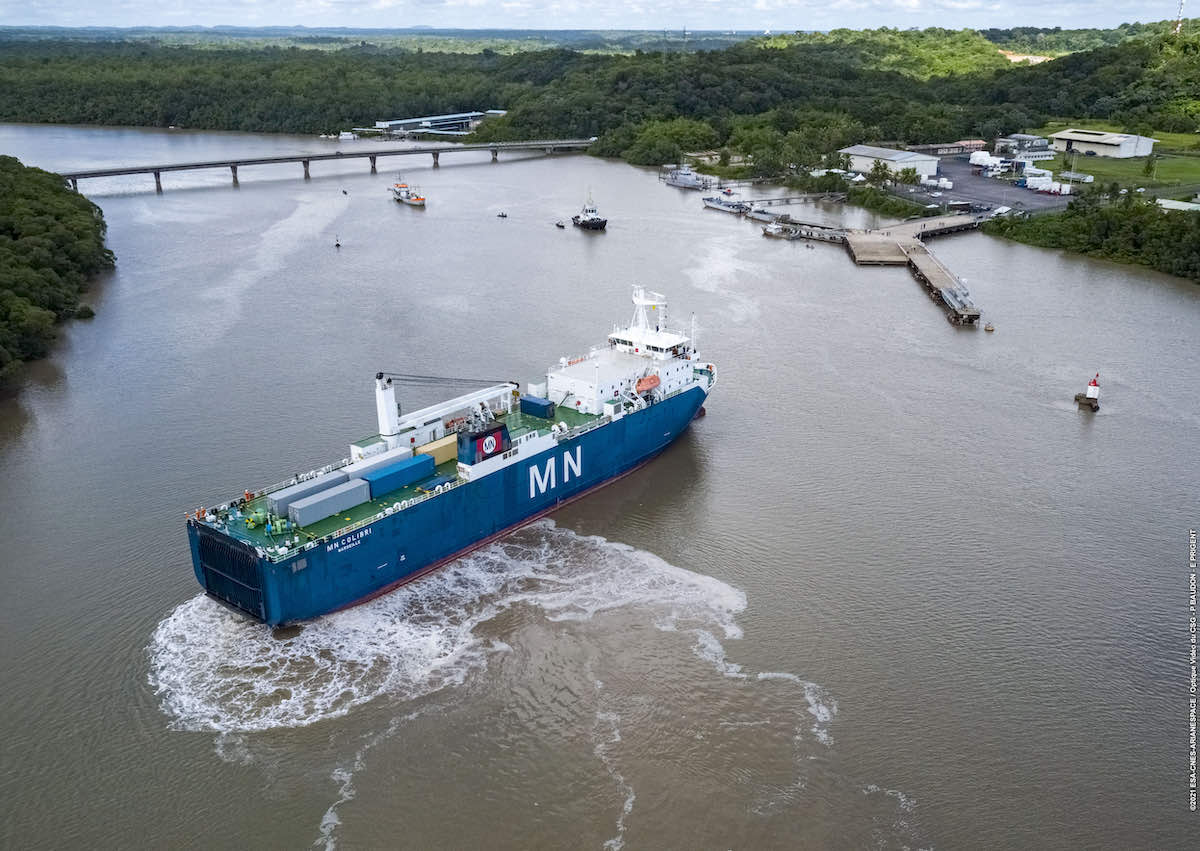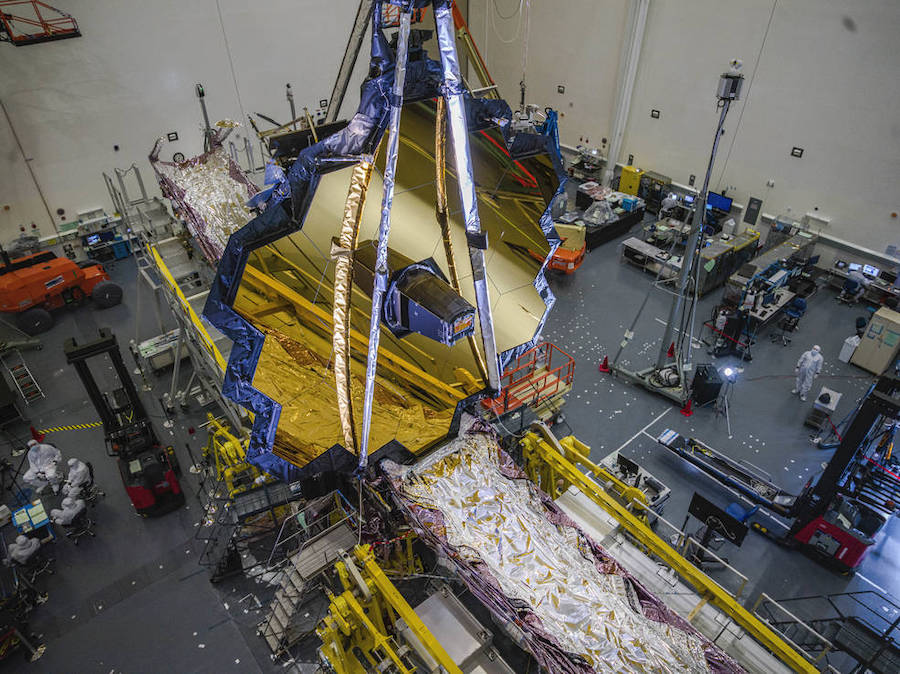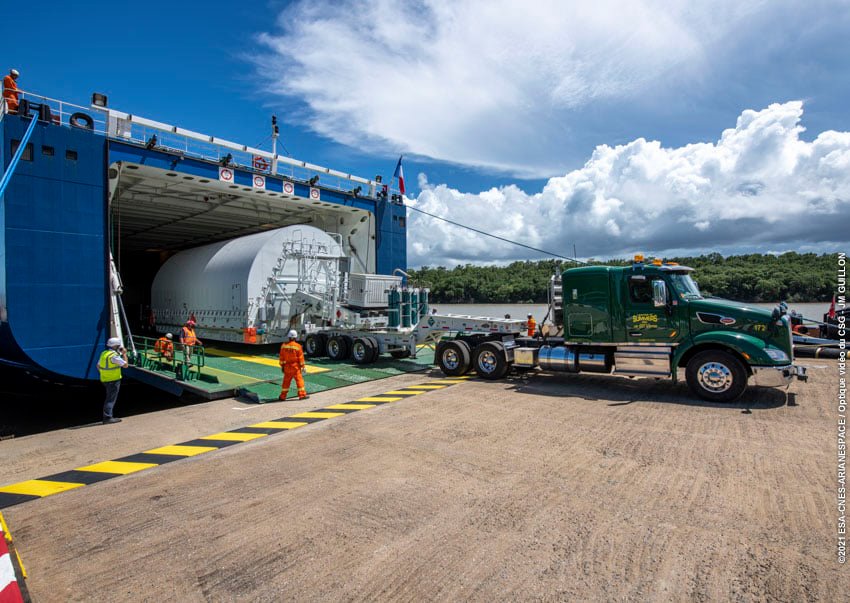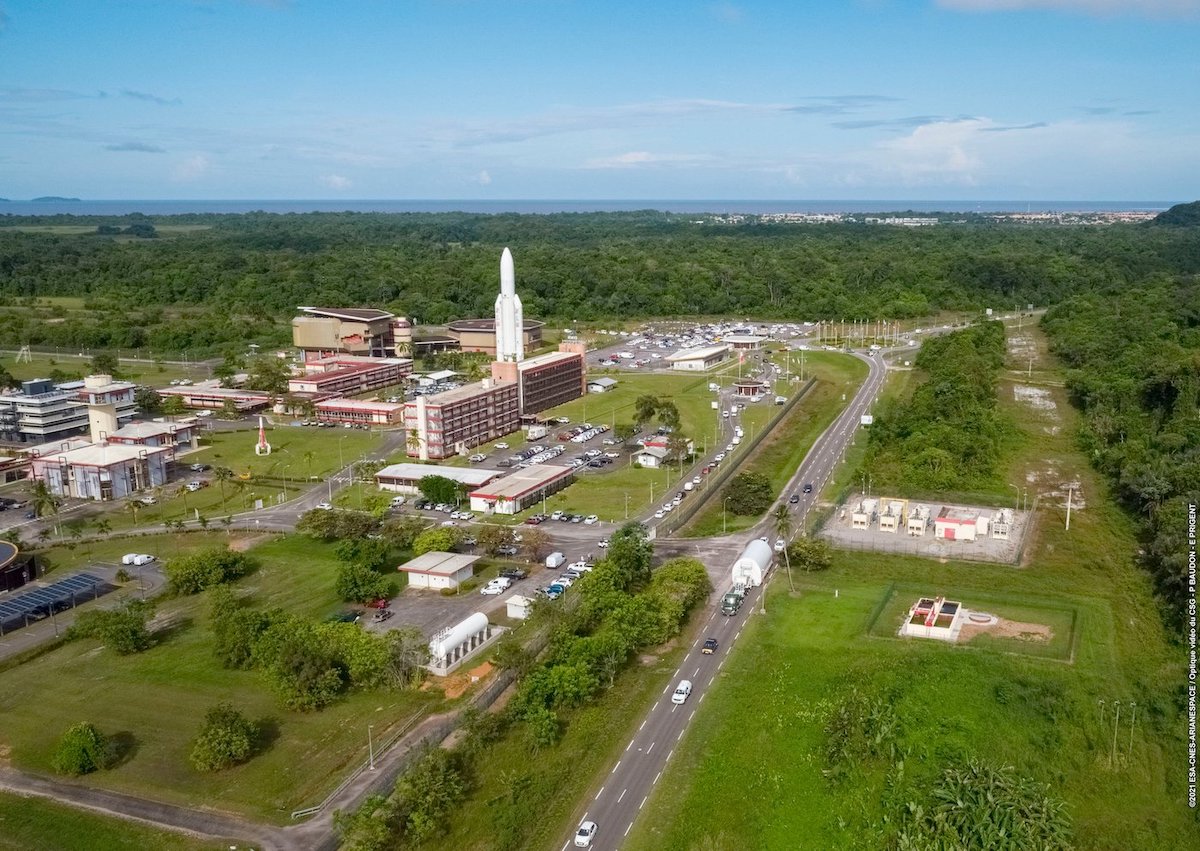
The James Webb Space Telescope, a successor to Hubble, arrived at the European Space Agency’s launch base Tuesday in Kourou, French Guiana, for final checkouts and fueling ahead of blastoff in December on top of an Ariane 5 rocket.
The $10 billion observatory pulled into port at Pariacabo harbor in Kourou, French Guiana, aboard the French-flagged MN Colibri transport ship Tuesday, completing a 16-day, 5,800-mile (9,300-kilometer) journey from Seal Beach, California.
Ground teams later pulled the spacecraft from the transport ship, then trucked the observatory inside its custom-built shipping container to the S5 payload processing facility at the Guiana Space Center on the northern shore of French Guiana.
The arrival of Webb in French Guiana kicks off a two-month launch campaign leading up to blastoff on an Ariane 5 rocket. Launch from the tropical spaceport is currently scheduled for Dec. 18.
“The James Webb Space Telescope is a colossal achievement, built to transform our view of the universe and deliver amazing science,” said NASA Administrator Bill Nelson in a statement. “Webb will look back over 13 billion years to the light created just after the big bang, with the power to show humanity the farthest reaches of space that we have ever seen.
“We are now very close to unlocking mysteries of the cosmos, thanks to the skills and expertise of our phenomenal team,” Nelson said.
NASA kept specific schedule details about the observatory’s journey from California to French Guiana under wraps for security reasons. In a statement Tuesday after Webb’s arrival in French Guiana, NASA said the observatory departed a Northrop Grumman facility in Redondo Beach, California, on Sept. 24, for a 26-mile (40-kilometer) trip by road to Naval Weapons Station Seal Beach.
The Webb telescope was loaded into the MN Colibri cargo ship, which Arianespace and ESA regularly use to carry rocket and satellite hardware from Europe to French Guiana. The ship departed California on Sept. 26, entered the Panama Canal on Oct. 5, then crossed the Caribbean Sea before arriving in Kourou.
Webb, an observatory more than two decades in the making, is a joint project between NASA, ESA, and the Canadian Space Agency. The Ariane 5 launch for Webb is part of ESA’s contribution to the mission, which is widely heralded as the most complex robotic spacecraft ever sent into space.

The observatory weighs just 6 metric tons, but its climate-controlled shipping container tips the scales at more than 70 metric tons, according to ESA.
The shipment of Webb to Kourou caps a winding journey for the observatory, including its gold-coated telescope mirrors and science instruments. The mirrors were fabricated, polished, and tested at locations in Ohio, Alabama, California, and Colorado at contractor Ball Aerospace, then transported to NASA’s Goddard Space Flight Center in Maryland for assembly into Webb’s telescope element.
Webb’s four science instruments were delivered to Goddard from the United Kingdom, Germany, California, and Canada. Engineers at Goddard assembled the instruments into Webb’s science module, and started putting together the telescope in 2013.
The telescope was shipped to NASA’s Johnson Space Center in Houston in 2017 for cryogenic testing, then to Northrop Grumman in Southern California for integration with the spacecraft element and sunshield.
“A talented team across America, Canada, and Europe worked together to build this highly complex observatory,” said Thomas Zurbuchen, associate administrator for NASA’s science mission directorate, in a statement. It’s an incredible challenge – and very much worthwhile. We are going to see things in the universe beyond what we can even imagine today.”
The Ariane 5 rocket will send Webb to an operating post nearly a million miles (1.5 million kilometers) from Earth.

After launch, the observatory will begin a make-or-break sequence of deployments to extend its solar array, high-gain antenna, and mirror segments. Webb also has a five-layer sunshield to shade its mirrors, detectors and science instruments, keeping the telescope colder than minus 370 degrees Fahrenheit, or minus 223 degrees Celsius.
Made of aluminum-coated Kapton, each sunshield layer is as thin as a human hair. The sunshade will expand to the size of a tennis court once Webb is in space.
The observatory’s infrared instruments will peer into the oldest, most distant reaches of the universe to study some of the first stars and galaxies that formed after the Big Bang more than 13.5 billion years ago.
Astronomers will also use Webb to look at how galaxies form and evolve, to study the birth of stars, and to learn more about the atmospheres of planets that may be hospitable for life outside our solar system.
With Webb now in French Guiana, ground teams will unpack the observatory from its shipping crate and begin “aliveness” and systems tests to make sure the spacecraft weathered the intercontinental journey from California.
Ground support equipment for Webb previously arrived at the Guiana Space Center after a delivery to nearby Cayenne, French Guiana, on a U.S. Air Force C-5 cargo plane.
Controllers at the Space Telescope Science Institute in Baltimore will take command of Webb after it separates from the Ariane 5 rocket about a half-hour after liftoff. Smith said the control team in Baltimore will conduct a final readiness exercise for Webb’s launch and commissioning next month.

Webb shipped to Kourou in its folded launch configuration, measuring 34.4 feet (10.5 meters) tall and 14.8 feet (4.5 meters) wide. The Ariane 5’s payload compartment is one of the largest of any operational rocket, but Webb must launch with its mirrors, sunshield, and solar arrays tucked in to fit inside the fairing.
Other work planned at the Guiana Space Center includes mounting of Webb to its payload adapter, the structure that will attach it to the top of the Ariane 5 rocket. Then technicians will load toxic hydrazine and nitrogen tetroxide propellants into the spacecraft.
The liquid propellants will feed Webb’s maneuvering thrusters to keep the spacecraft on course toward its destination a million miles from Earth, and maintain its trajectory around the second Lagrange point, or L2. In orbit around L2, the balance of the gravitational pull from the Earth and sun will keep Webb in a relatively stable region, giving the observatory unimpeded views of deep space.
Ground crews in French Guiana will next move the spacecraft to the Ariane 5 rocket’s final assembly building for stacking on top of the launcher. Then the fully-assembled Ariane 5 will roll out to the launch pad at the Guiana Space Center for final preparations.
Email the author.
Follow Stephen Clark on Twitter: @StephenClark1.
